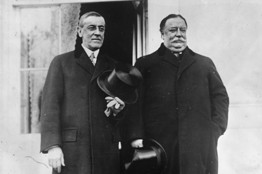It’s Tuesday, September 27th, 2011….but before we begin, here’s a quick history lesson….factual history….on the origins of our income tax from John Steele Gordon in the WSJ to complement Bill Whittle’s must-view Arab-Israeli video primer in link #2 on the home page:
A Short History of the Income Tax
One original sin was the separation of the corporate and personal tax, giving lawyers, accountants and the wealthy a chance to game the system.
Whether the “millionaires and billionaires” are actually paying their fair share of taxes is a matter for the electorate to decide. After all, fairness is hardly an objective standard. (As well as a term you’ll never hear a Liberal actually define!)
Before the modern era, however, the federal tax system was manifestly unfair by any reasonable standard, grossly biased in favor of the well off. Ironically, attempting to fix that unfairness is what has brought us to the present moment, with a federal tax system that is grotesquely complex, often arbitrary, and corrupted by mutual back-scratching between members of Congress and influential lobbyists.
 A wimp, and a blimp!
A wimp, and a blimp!
After the Civil War, nearly all the wartime taxes—including the nation’s first income tax—were repealed and the federal government relied mostly on the tariff for revenues. It provided the government with more than ample peacetime income. In 1882, the government had revenues of $403 million, but expenses were only $257 million, a staggering budget surplus of nearly 36%. The reason the tariff was so high was, ostensibly, to protect America’s burgeoning industries from foreign competition.
Of course, the owners of those burgeoning industries—i.e., the rich—were greatly helped by the protection, which enabled them to charge higher prices and make greater profits than if they had had to face unbridled foreign competition.
But the tariff is a consumption tax, which is simply added to the price of the goods sold. And consumption taxes are inherently regressive. The poor, by definition, must spend all of their income on necessities and thus pay consumption taxes on all of their income. The rich, while living in luxury, bank most of their income and largely escape these types of taxes.
As the vast surpluses piled up in the Treasury, the political pressure to institute an income tax on the rich grew steadily. In 1894, with Democrat Grover Cleveland in the White House and Democratic majorities in both houses of Congress, a federal income tax became law. The new tax, however, was very different from the Civil War income tax, which had exempted only the poor. The new one hit only the rich, imposing a 2% tax on incomes above $4,000. Less than 1% of American households in 1894 met that income threshold.
Needless to say, the tax was attacked in court, in a 1895 test case called Pollack v. Farmers’ Loan & Trust. The case turned on the definition of a “direct tax,” which the Constitution requires to be apportioned equally among the states according to population, something obviously impossible with an income tax.
The court split 4-4 as to whether the new income tax was constitutional. One member of the court, Justice Howell Jackson of Tennessee, was absent because of illness (and died less than three months later). But with the case drawing enormous public attention, the court agreed to reargue it and Justice Jackson rose from his deathbed to hear it.
Jackson was known to favor the income tax and it was assumed that it would now be upheld 5-4. But one of the other justices switched his vote (the opinion is unsigned and we don’t know by whom or why) and it was voted down 5-4.
The income tax was dead. But the pressure to tax the incomes of the largely untaxed rich only increased, especially as the Progressive wing of the Republican Party grew in strength under Theodore Roosevelt. By the time of the administration of President William Howard Taft (1909-13) the pressure was becoming overwhelming. One representative suggested simply repassing the 1894 tax bill and daring the Supreme Court to overturn it a second time.
That idea horrified Taft, who revered the court. He feared that it would weaken its position as the final arbiter of the Constitution. He came up with a brilliant, very lawyerly, alternative: He proposed a constitutional amendment to legalize a personal income tax, while meanwhile imposing a tax on corporate profits. In the early 20th century such a tax was, in effect, a tax on the rich. As the corporate income tax is technically an excise tax, there was no constitutional problem. Taft’s solution was implemented and in 1913 the 16th Amendment was declared ratified, just as Taft was leaving office.
The new president, Woodrow Wilson, and the strongly Democratic Congress promptly passed a personal income tax. It kicked in at 1% on incomes above $3,000 (a comfortable upper middle-class income at the time) and reached 7% on incomes over $500,000. But there were many deductions, bringing the effective tax rates down sharply from the marginal ones—a feature of the tax system ever since.
Unfortunately the corporate income tax, originally intended as only a stopgap measure, was left in place unchanged. As a result, for the last 98 years we have had two completely separate and uncoordinated income taxes. It’s a bit as if corporations were owned by Martians, otherwise untaxed, instead of by their very earthly—and taxed—stockholders.
This has had two deeply pernicious effects. One, it allowed the very rich to avoid taxes by playing the two systems against each other. When the top personal income tax rate soared to 75% in World War I, for instance, thousands of the rich simply incorporated their holdings in order to pay the much lower corporate tax rate.
There has since been a sort of evolutionary arms race, as tax lawyers and accountants came up with ever new ways to game the system, and Congress endlessly added to the tax code to forbid or regulate the new strategies. The income tax act of 1913 had been 14 pages long. The Revenue Act of 1942 was 208 pages long, 78% of them devoted to closing or defining loopholes. It has only gotten worse.
The other pernicious consequence of the separate corporate and personal income taxes has been a field day for demagogues and the misguided to claim that the rich are not paying their “fair share.” Warren Buffett recently claimed that he had paid only $6.9 million in taxes last year. But Berkshire Hathaway, of which Mr. Buffett owns 30%, paid $5.6 billion in corporate income taxes. Were Berkshire Hathaway a Subchapter S corporation and exempt from corporate income taxes, Mr. Buffett’s personal tax bill would have been 231 times higher, at $1.6 billion.
Just as in the late 19th century, the tax code is now hopelessly arbitrary and unfair. It requires a complete overhaul.
So now….you know!
And without further ado, here’s the Gouge!
Leading off today’s edition, the WSJ offers evidence of….
A Real Robo-Signing Scandal
Look who knew about the problem all along.
State Attorneys General were shocked—shocked!—to discover sloppy foreclosure practices last year in the wake of the housing boom and bust, and they have used that revelation to try to squeeze billions of dollars out of the nation’s largest banks. Here’s a bigger scandal: Fannie Mae knew about the problem years ago.
In a report issued Friday to little media notice, the Inspector General for the Federal Housing Finance Agency (FHFA) found that “in 2005, Fannie Mae hired an outside law firm to investigate a variety of allegations referred by one of its investors regarding purported foreclosure processing abuses and other matters.” The next year the law firm reported back that some practices, such as filing false paperwork, were “unlawful” and should stop, and it noted that Fannie was implementing a computer system to improve oversight of its foreclosure processing attorney network.
So far, so good—except for what didn’t happen next. The IG says that neither Fannie nor its regulator FHFA acted on the 2006 report, and the computer system also didn’t materialize. FHFA “examination officials” only learned of the report’s existence in March after reading an article in this newspaper.
The IG’s report again highlights the loose rules that Fannie and Freddie Mac operated under during the housing boom. Fannie “placed a higher priority on meeting specific earnings goals than it did on ensuring proper accounting, risk management, internal controls, and complete and accurate financial reporting,” the IG report recalls from a prior review. (Gee….that wouldn’t have anything to do with those obscene bonuses Franklin Raines, Jamie Gorelick and other prominent Dims took home?!?)
In a letter responding to the IG, FHFA Associate Director Elizabeth Scholz mused: “An effective operational risk program would not have prevented servicing personnel and licensed attorneys from engaging in improper, unethical or fraudulent practices.” Maybe not, but since we’re talking hypotheticals, wouldn’t better oversight of foreclosure practices have helped mitigate the problem?
So far no one has uncovered evidence that banks kicked nondelinquent borrowers out of their homes, despite robo-signing and other sloppy paperwork. Surely the practices of Fannie and Freddie deserve equal scrutiny.
Next up, it’s the “Desperately Seeking Political Relevance In The Face Of A Certain Primary Battle” segment, brought to us today by a man destined never to either achieve greatness nor have it thrust upon him:
Graham Doesn’t Rule Out Military Action Against Pakistan if No Crack Down on Extremists
Unless Senator Grahamnesty has his own private army poised to invade Pakistan, who the hell cares WHAT Lindsay thinks….about this or any other issue?!? We say come 2014, good riddance….
 ….to RINO rubbish!
….to RINO rubbish!
And in the “THEN what?!?” segment, Police Commissioner Ray Kelly assures residents of the Big Apple….
NYPD Chief: Police Could Take Down Plane if Needed
That’s great, Ray; but then….

….what?!? Or did you think these things just vaporized in mid-air after you hit them?
Turning to our continuing coverage of Campaign 2012, we learn….
ABC Dismisses ‘Pizza Baron’ Cain: ‘Nobody’ Won the FL Straw Poll
Good Morning America’s John Hendren on Sunday dismissed the victory of Herman Cain in the Florida straw poll, condescendingly asserting that the “big winner is nobody.” The ABC reporter made sure to repeatedly mention the business of the Republican presidential candidate: “That’s right. The man who brought you Godfather’s Pizza at 37 percent.“
Hendren arrogantly explained, “What’s notable about the Florida straw poll is less who won than who lost…The week’s big winner in the Republican primary is nobody.” It’s odd for ABC to dismiss the straw poll’s actual winner as a “nobody.” But if the candidate hasn’t broken through, perhaps GMA should actually consider having him on as a guest. (This has yet to happen in 2011.)
On Sunday’s World News, Hendren insisted that Texas Governor Rick Perry “left humiliated and humbled, a distant second to Herman Cain, the man from Godfather’s Pizza.”
Correspondent John Berman on Monday reiterated, “He finished a shocking second to pizza baron Herman Cain in the Florida straw poll.”
We frankly have yet to pick a horse in this race; and while we like Cain well enough, we certainly perceive both pluses and minuses to his candidacy. However, we find it more than passing strange the MSM would seek to minimize and dismiss Cain’s undeniable business acumen and management success when we can’t recall the their darling, Barack Hussein Obama, ever having actually built, established, developed or accomplished anything….anywhere….anytime….prior to occupying the Oval Office….though he’s certainly been busy….

….ever since!
Speaking of persons, places and things hemorrhaging huge amounts of red ink:
Living People Eligible to Appear on U.S. Stamps for First Time
The U.S. Postal Serviceannounced Monday that it is ending its longstanding rule that stamps cannot feature people who are still alive and it’s asking the public to offer suggestions on who should be first. The post office announced that it will consider stamps for acclaimed American musicians, sportsstars, writers, artists and other nationally known figures.
“This change will enable us to pay tribute to individuals for their achievements while they are still alive to enjoy the honor,” Postmaster General Patrick Donahoe said in a statement. Stamp Services manager Stephen Kearney said, “Engaging the public to offer their ideas is an innovative way to expand interest in stamps and the popular hobby of collecting them.”
They are inviting suggestions through Facebook, Twitter, a postal service website and, of course, by mail to the Citizens’ Stamp Advisory Committee, c/o Stamp Development, Room 3300, 475 L’Enfant Plaza SW, Washington DC 20260-3501. The advisory committee receives as many as 40,000 suggestions for new stamps each year and culls them down to about 50 finalists, which are sent to the postmaster general for a final decision.
With the USPS facing a likely deficit of over $10B this coming year, are we the only one somewhat surprised they’d be spending money on anything but the cheapest possible stamp designs?
Since we’re on the subject of wasting money, here’s today’s Environmental Moment, and an spot-on article by AEI‘s Steve Hayward writing in The Weekly Standard that details:
President Solyndra
And his mean green wealth-wasting machine
“….The Solyndra story includes Obama campaign donors and everybody’s favorite Wall Street whipping boy, Goldman Sachs, in the middle of the whole sorry mess. Yet it would be a mistake to mark the story down as merely another excrescence of crony capitalism. It is much worse.“
http://www.aei.org/article/104185
Then there’s this bit of pointed prose from Daniel Halper in The Weekly Standard, courtesy of Bill Meisen:
Solar Decathlon’s Rainy Start
The Department of Energy’s Solar Decathlon kicked off today in Washington on the National Mall, under inauspiciously dark rainy skies. In a press release announcing the competition, Department of Energy Secretary Steven Chu is quoted as saying, “The Solar Decathlon collegiate teams are showing how clean energy products and efficient building design can help families and businesses reduce energy use and save money…The event challenges talented students to become pioneers of clean energy technology and helps ensure that out nation remains competitive in the workforce of tomorrow.”
Chu has reason to be hopeful that the competition pays off: The Department of Energy gives a $100,000 grant to each team just to participate in the Solar Decathlon, in addition to all the other costs of hosting and producing the competition. (Some of the other costs are offset by the myriad sponsors–from Lowe’s to Pepco.)
The City College of New York’s team proudly showed off their house to me this morning at the competition:

Teisha Villegas, a fifth year architecture student at CCNY, was a bit cagey with the details, but it looked nice inside! “I’m not sure,” Villegas said when I asked how many kilowatts the 40 solar panels on the roof were bringing in today. “I haven’t had a reading on a bright sunny day.”
The house has the potential to bring in 8 kilowatts of energy (although not on a day like this).
When I asked how much the house cost, Villegas was again slow to reveal the details. “Not one of the cheap ones,” she said, saying that since it was built in New York City it had to meet the city’s strict codes. “I can’t say the price tag because we’re still negotiating with the affordability people.” One element of the competition is to be able to build affordable green energy housing.
Finally, Villegas conceded the price tag came to about $450,000, “which is just parts” since CCNY students did all the labor. Another student from the same team, Yinery Baez, also a fifth year architecture student, said that $500,000 is a more accurate figure, but that they believe the price could be dropped to about $300,000 if it were ever to be mass produced.
Depending on who you asked, the square footage of the home is either 650 (Villegas) or 750 (Baez).
Since the Department of Energy only picks up $100,000, I wondered how the college teams were able to pick up the rest of the costs. For the CCNY team, they are fortunate enough to have generous benefactors, including the Spitzer family (of which former governor Eliot Spitzer is the most famous member).
The Department of Energy’s press release ends by saying, “The Solar Decathlon also provides participating students with hands-on experience and unique training that prepares them to enter our nation’s clean energy workforce, supporting the Obama Administration’s goal of transitioning to a clean energy economy while saving families and business money.” But while there might not be many clean energy jobs for these students to get after graduation, this program must surely be a cheaper alternative to investing in solar energy than Solyndra was for the Obama administration–both in terms of capital and political capital.
As Mr. Meisen so accurately observed:
First, who would pay $500,000 for a 700 square foot house. Second, this solar house produces up to 8 kw while the sun is shining. Today, we pay about 8 cents per kw/h for electricity produced by coal. So let’s do the math.
8 kw @ 8 cents per kw/h = 64 cents of energy per hour.
Average of 12 hours of sunlight per day = $7.68 of energy per day
$7.68 times 365 days a year = $2,803.20 of energy savings per year.
At this rate, it would take almost 36 years just to pay of the original $100,000 grant in energy savings. What a deal!!!
Your tax dollars at work, people….your tax dollars at work!
On the Lighter Side….






And in Nobel News….
First Kenyan Woman to Win Nobel Peace Prize Dies at 71
In a related headline which bodes ill for the America we know and love:
First Kenyan Man to Win Nobel Peace Prize Still Alive

Finally, we’ll call it a day with News of the Bizarre, and this just in from Arkansas:
Arkansas Man Accused of Asking to Suck Women’s Toes
An Arkansas man who was convicted in the 1990s for making comments about women’s feet has been arrested for allegedly telling two women he wanted to suck their toes. Michael Robert Wyatt faces misdemeanor harassment charges after two women claimed he said he wanted to suck their toes.
At this point you’re likely thinking, “a little unusual….but not for Arkansas”, right? And now, as the late, great Paul Harvey used to say, the rest of the story!
Wyatt, of Vilonia, Ark., was convicted of felony terroristic threatening in 1991 for telling a woman he would cut off her feet and suck her toes while she bled to death.
Our 55+ years on Earth have certainly provided ample opportunity for some inexplicably random thoughts to course through our cranium….but this ain’t one of ’em! Is this a great country or WHAT?!?
Magoo
















You must be logged in to post a comment.